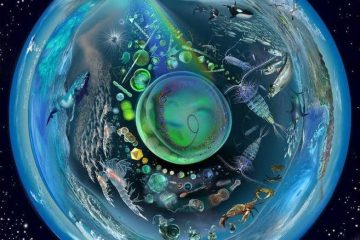Table of Contents
- Exploring the Foundations of the Gaia Hypothesis
- Assessing the Interconnectedness of Life and Earth Systems
- Implications of the Gaia Hypothesis for Environmental Sustainability
- Practical Applications of the Gaia Hypothesis in Modern Science
- Engaging in Critical Discussions Around the Gaia Hypothesis
- Q&A
- Concluding Remarks

Exploring the Foundations of the Gaia Hypothesis
The Gaia Hypothesis, proposed by James Lovelock in the 1970s, offers a compelling perspective on the interconnectedness of life and the environment on Earth. At its core, this theory suggests that the planet and its biological systems behave as a single, self-regulating entity. Through a delicate interplay of organisms and their surroundings, Earth maintains conditions suitable for life. Some of the key elements driving this hypothesis include:
- Homeostasis: This refers to the ability of the Earth system to regulate its environment, ensuring a stable climate and balance in essential cycles like carbon and nitrogen.
- Feedback Mechanisms: Both positive and negative feedback loops play a crucial role in maintaining ecological balance. For instance, increased atmospheric CO2 can lead to warmer temperatures, which may in turn enhance plant growth, pulling carbon from the atmosphere.
- Biodiversity: The variety of life forms contributes to the resilience of ecosystems, enabling better adaptability to changes and stresses, thus supporting the overall health of the planet.
Scientific evidence supporting the Gaia Hypothesis spans various disciplines, including ecology, climatology, and geology. Researchers have observed that ecosystems exhibit characteristics akin to living organisms, with communal dynamics that ensure sustainability. For instance, studies indicate that:
| Study Focus | Findings |
|---|---|
| Coral Reef Ecology | Coral polyps and algae engage in a symbiotic relationship that sustains marine biodiversity. |
| Agricultural Sustainability | Diverse cropping systems enhance soil health and stabilize yields against climate variations. |
| Atmospheric Studies | Atmospheric gases are largely regulated by biological processes, showcasing feedback loops. |
Understanding the Gaia Hypothesis inspires a holistic approach to environmental stewardship. Acknowledging that humans are a part of this intricate system shifts our responsibility towards the Earth. By fostering sustainable practices and recognizing our impact, we can contribute to the planet’s ability to thrive. Promoting such awareness can help guide future policies and actions, ensuring that all life forms can coexist harmoniously within this vital, self-regulating system.

Assessing the Interconnectedness of Life and Earth Systems
The intricate balance of life on Earth can be likened to a finely tuned orchestra, where every instrument plays a vital role in the overall symphony. Various components of life—from flora and fauna to microorganisms—interact with inorganic elements like air, water, and minerals to maintain ecological equilibrium. This interdependence underscores the importance of understanding how biological and geological systems influence one another.
For instance, the presence of plants not only contributes to oxygen production but also affects the climate and soil health. Conversely, microorganisms such as bacteria and fungi decompose organic matter, recycling essential nutrients back into the ecosystem. The consequences of disruptions in these relationships can be profound, resulting in phenomena such as soil erosion, loss of biodiversity, and changes in atmospheric conditions:
- Climate Change: Altered weather patterns affecting species survival.
- Biodiversity Loss: Extinction of species decreasing ecosystem resilience.
- Soil Degradation: Nutrient depletion leading to reduced agricultural productivity.
Understanding the complexity of these interactions can aid in developing strategies to mitigate environmental issues. For example, reforestation efforts can not only enhance biodiversity but also improve carbon sequestration. Similarly, conservation initiatives that protect wetlands can bolster natural filtration processes, thereby improving water quality and habitats. A systematic approach to analyzing these interactions can yield transformative solutions to pressing environmental challenges, making it crucial for researchers and policymakers to factor in these interconnections when formulating conservation strategies.
Implications of the Gaia Hypothesis for Environmental Sustainability
The Gaia Hypothesis, introduced by James Lovelock in the 1970s, posits that Earth functions as a self-regulating, interconnected system that maintains conditions conducive for life. This perspective shifts the traditional understanding of environmental interaction, suggesting that all living organisms and their inorganic surroundings are tightly interwoven. When considering environmental sustainability, the implications of this hypothesis compel us to rethink our role within ecosystems and emphasize a more holistic approach to environmental stewardship.
Adopting the Gaia Hypothesis encourages us to recognize the essential relationships between all forms of life and the physical environment. Key implications include:
- Interconnectedness: Understanding that every action has repercussions across the biosphere promotes responsible practices in resource management.
- Long-term thinking: Sustainable development requires consideration of future generations and ecological balance, advocating for practices that repair rather than deplete.
- Collaborative efforts: A community-focused approach to environmental issues ensures that diverse perspectives are incorporated, leading to more effective solutions.
By viewing the planet as a living organism, we are prompted to adopt strategies that bolster resilience, enhance biodiversity, and promote a sustainable future. The increasing awareness of climate change, habitat destruction, and species extinction underscores the need for adaptive management that aligns with the principles of the Gaia Hypothesis. For instance, implementing regenerative agricultural practices can restore soil health and biodiversity while also sequestering carbon. Below is a simple comparison table showcasing traditional agriculture vs. regenerative practices:
| Aspect | Traditional Agriculture | Regenerative Agriculture |
|---|---|---|
| Pesticide Use | High | Minimal |
| Soil Health | Degraded | Improved |
| Biodiversity | Low | High |
Embracing the Gaia Hypothesis not only enriches our understanding of environmental sustainability but also reshapes our approaches to address pressing ecological crises. By working in harmony with nature, rather than against it, we move toward a more sustainable existence that respects the intricate web of life on Earth.

Practical Applications of the Gaia Hypothesis in Modern Science
The Gaia Hypothesis has ignited a paradigm shift in how we understand the intricate relationships between living organisms and their environment. This holistic perspective encourages scientists to explore ecological balance and sustainability by treating the Earth as a self-regulating system. Practical applications of this theory can be witnessed in fields such as ecology, environmental science, and even medicine. For instance, recognizing that natural ecosystems are often self-sustaining prompts researchers to study how biodiversity contributes to this balance, developing models that can predict the outcomes of ecosystem changes.
In agriculture, the Gaia Hypothesis drives innovative approaches towards sustainable farming practices. By recognizing the interdependence of crops, soil, and pests, farmers are adopting techniques like permaculture and agroecology. These practices not only enhance soil fertility and crop yield but also minimize the use of synthetic fertilizers and pesticides. This eco-centric approach brings forth the concept of the ‘farm as an ecosystem,’ where every element is vital in maintaining the health of the agricultural environment.
| Gaia-Inspired Practices | Benefits |
|---|---|
| Permaculture | Enhances biodiversity and soil health |
| Agroforestry | Increases yield while providing habitat |
| Rotational Grazing | Improves pasture recovery and soil carbon |
Additionally, the Gaia Hypothesis extends into the realm of climate science, where it compels scientists to understand Earth’s systems more comprehensively. By studying the interactions between carbon cycles, temperature changes, and biotic components, researchers can forecast perilous climatic shifts. This integrative view supports principle climate policies, emphasizing the need for global collaboration to counteract adverse environmental impacts. Through this lens, urgent actions stem from a well-rounded comprehension of our planet’s intricate dynamics.

Engaging in Critical Discussions Around the Gaia Hypothesis
Delving into the complexities of the Gaia Hypothesis necessitates a multi-faceted conversation that transcends mere scientific inquiry. Critics and supporters alike can benefit from engaging with the hypothesis through various lenses, such as philosophy, ethics, and environmental science. This intersection of disciplines fosters a rich tapestry of discussions that highlight the implications of viewing Earth as a self-regulating entity. Participants in these discussions should consider the moral obligations we have to the planet and each other, particularly in a time marked by climate change and ecological degradation.
Incorporating various viewpoints stimulates critical thought and encourages individuals to question their assumptions about nature and humanity’s place within it. Key points for discussion could include:
- The role of evolutionary biology in understanding ecological interactions.
- The implications of treating Earth as a single, living system on policy-making and conservation strategies.
- The ethical considerations surrounding our responsibilities to future generations and non-human life.
Engaging in critical discussions can also be enhanced by using structured arguments and data-driven insights. One way to achieve this is through the use of comparative analysis, where historical perspectives on ecosystems are contrasted with contemporary understandings. To illustrate this point, the table below outlines historical ideologies compared to the Gaia Hypothesis:
| Historical Ideology | Gaia Hypothesis Perspective |
|---|---|
| Nature as a resource | Nature as a living system |
| Isolation of species | Interconnected ecosystems |
| Human dominance over nature | Symbiotic relationship with the Earth |
Such comparisons provide a strong basis for dialogue, emphasizing both the shifts in thought and the pressing need for a redefined relationship with our environment. This structured approach encourages a deeper exploration of the challenges and opportunities that the Gaia Hypothesis presents in understanding our complex world.
Q&A
Q&A: Understanding the Gaia Hypothesis Assignment
Q1: What is the Gaia Hypothesis? A: The Gaia Hypothesis proposes that the Earth and its biological systems behave as a single, self-regulating entity. Coined by scientist James Lovelock in the 1970s, this theory suggests that living organisms interact with their inorganic surroundings to maintain conditions for life on the planet, contributing to a balance that sustains the biosphere.Q2: What does an assignment on the Gaia Hypothesis typically involve? A: An assignment on the Gaia Hypothesis often includes exploring its scientific basis, discussing its implications for environmental science, and examining its philosophical aspects. Students might be asked to research case studies, analyze real-world examples of ecological balance, or critically assess the hypothesis’s validity in today’s environmental context.
Q3: Why is the Gaia Hypothesis significant in contemporary discussions about ecology? A: The Gaia Hypothesis is significant because it encourages a holistic view of Earth’s systems. In an era grappling with climate change and ecological degradation, this perspective emphasizes the interconnectedness of life and the importance of protecting ecological balances. It pushes us to consider how human actions affect the planet’s health and urges collaborative efforts for sustainability.
Q4: How can I approach my Gaia Hypothesis assignment creatively? A: To creatively approach your assignment, consider utilizing different formats. You might create a multimedia presentation that combines scientific data with artistic representations of Gaia theory. Alternatively, a short story or narrative that personifies the Earth and its ecosystems can illustrate the concepts in an engaging way. Think outside the box to connect the hypothesis with current global issues!
Q5: Are there any key figures or scientists I should research for my assignment? A: Yes! Besides James Lovelock, you should also explore the works of Lynn Margulis, whose research on symbiosis complements the Gaia Hypothesis. Additionally, looking into contemporary scientists and environmentalists who advocate for Gaia’s principles can provide a modern perspective on the discussion.
Q6: What resources are recommended for researching the Gaia Hypothesis? A: There are numerous resources available, including academic journals, books like “Gaia: A New Look at Life on Earth” by James Lovelock, and online databases. Documentaries and educational websites can also offer insightful visuals and summaries that make complex ideas more accessible. Don’t forget to explore scholarly articles that critique or support the hypothesis for a balanced viewpoint!
Q7: How can I structure my assignment effectively? A: A clear structure is crucial for effective communication. Start with an introduction that outlines the Gaia Hypothesis and its significance. Follow this with sections on historical context, key concepts, implications for ecology, and critiques. conclude with your reflections on the current relevance of the hypothesis, suggesting what future studies should focus on.
Q8: What are common misconceptions about the Gaia Hypothesis? A: One common misconception is that the Gaia Hypothesis implies that Earth is a conscious being. While it personifies the planet and its systems, the hypothesis does not claim that Earth has awareness. Another misconception is that it rejects human impact; rather, it highlights the need to understand how our actions influence Earth’s systems and encourages us to consider our role in maintaining ecological balance.
With this Q&A, you should have a solid foundation for tackling your Gaia Hypothesis assignment. Engage creatively with the topic, and don’t hesitate to explore the intricate relationships between life and the Earth!



0 Comments